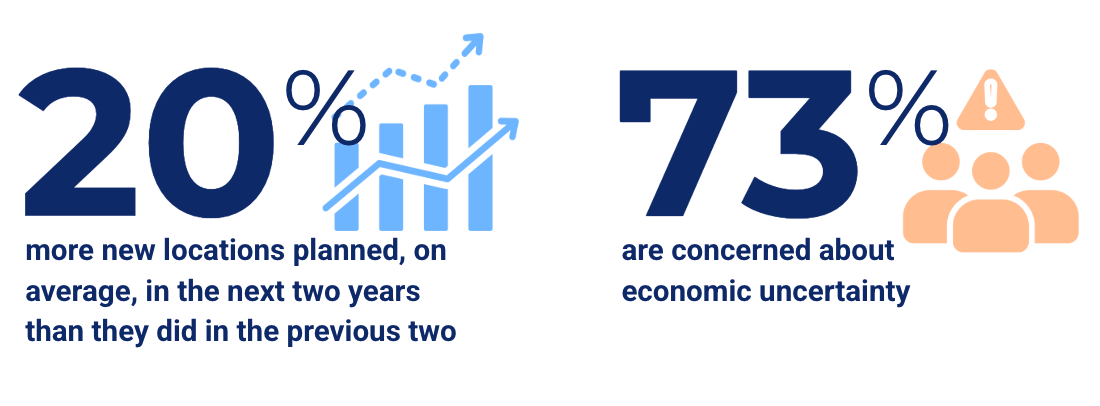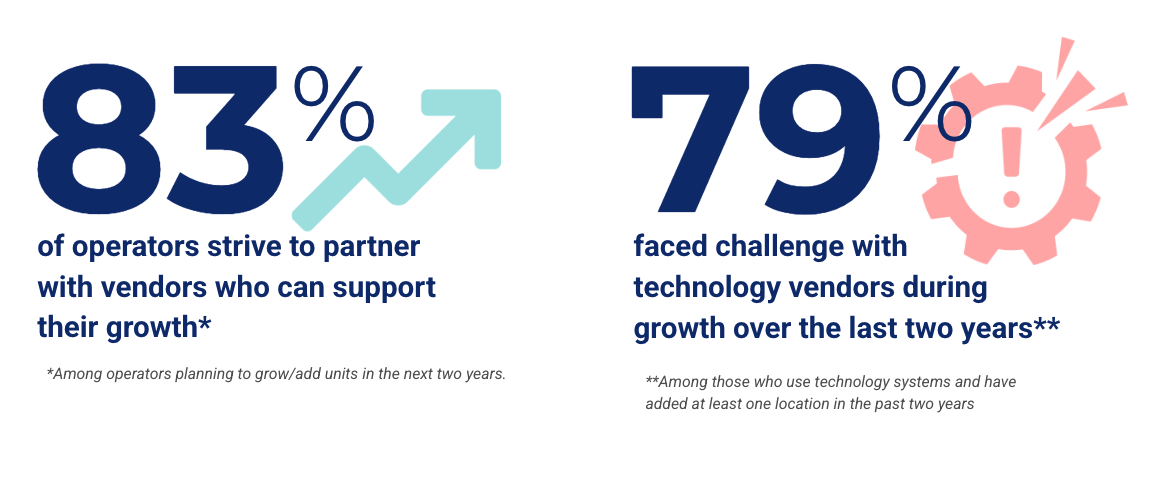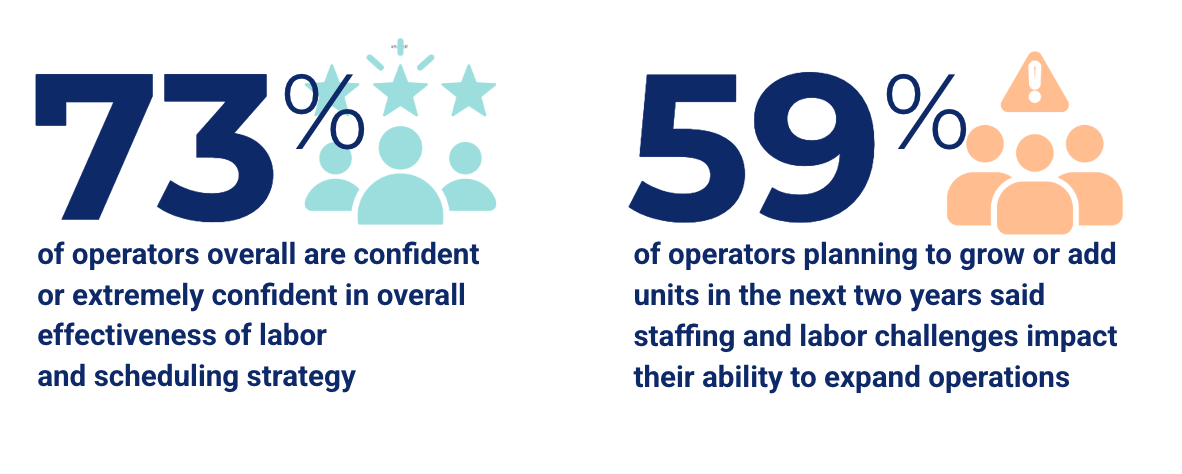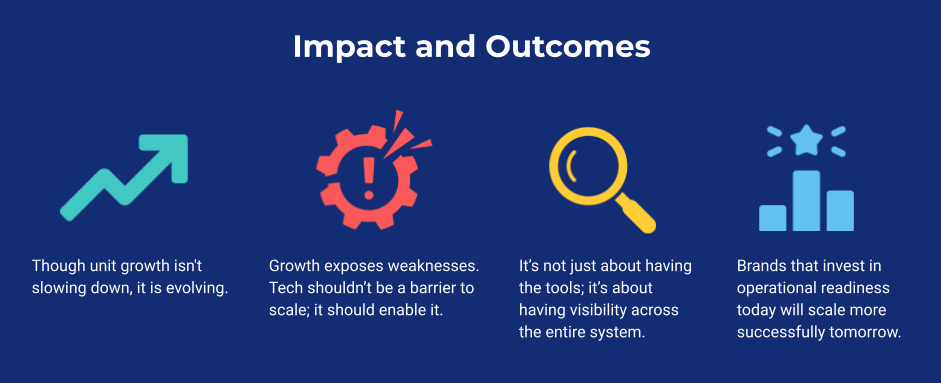![[New Research] Despite Economic Concerns, US Restaurant Operators Plan to Open 20% More Locations](https://www.crunchtime.com/hs-fs/hubfs/2025-Crunchtime-growth-research-report-hires_@2x-1.png?length=720&name=2025-Crunchtime-growth-research-report-hires_@2x-1.png)
- Home
- Crunchtime Blog
- [Webinar Recap] 2025 Restaurant Growth Insights Report
.jpg)
[Webinar Recap] 2025 Restaurant Growth Insights Report
Crunchtime x Technomic Research Webinar Recap
Earlier in 2025, Crunchtime partnered with Technomic to commission an in-depth quantitative research study exploring the main operational pain points and growth opportunities for multi-unit restaurant chains.
The findings, shared during a joint Crunchtime and Technomic webinar, shed light on how restaurant leaders are balancing expansion goals with economic uncertainty, operational challenges, and the evolving role of technology. The webinar was led by Donna Hood Crecca, Sr. Principal at Technomic and Cassandra Clark, VP of Marketing at Crunchtime.
About the Research
More than 300 multi-unit restaurant operators with decision-making authority participated in the anonymous survey conducted in spring 2025. Respondents represented a range of chain sizes:
- Small (10–19 locations): 41%
- Medium (20–100 locations): 37%
- Large (100+ locations): 22%
A majority (63%) held sole responsibility for technology decisions, while 37% shared that responsibility. The group represented a wide variety of restaurant segments, from quick-service and fast-casual to casual dining, family/midscale, and fine dining, with a mix of 43% franchisees and 57% corporate operators.
All findings were validated by Technomic for accuracy.
Growth Remains a Priority–Even Amid Uncertainty
Despite rising costs and broader economic concerns, operators aren’t slowing down. On average, restaurants plan to open 20% more new locations in the next two years compared to the previous two. At the same time, 73% of respondents said they are concerned about economic uncertainty.
Clark explained, “So what this tells us is that while sentiment is more cautious, growth is still very much a priority for multi-unit operators.”
Clark added, “Operators know that because of these economic headwinds, they can’t grow the same way that they have in the past, so they’re having to rethink how to grow effectively: by focusing on better operational efficiency and technology, as well as stronger vendor partners to help offset those external pressures that they are facing.”
Where Technology Makes the Biggest Impact
When asked where technology delivers the most value during uncertain times, operators pointed to two key areas:
- 45%: Better inventory management and waste reduction
- 35%: More accurate forecasting of food and labor costs
However, those same areas are also among the most challenging during growth periods–especially when it comes to staffing and scheduling:
- 37%: Attracting and retaining qualified staff
- 31%: Managing labor costs and scheduling
“We also see an interesting connection with this data: the same categories where technology is viewed as the most helpful are also where operators are feeling the most pain. This shines a big spotlight on the importance of internal readiness across both technology and process to help drive sustainable growth over time.” - Cassandra Clark, VP of Marketing, Crunchtime
Growth Depends on Strong Vendor Partnerships
Among operators planning to expand, 83% said it’s important to partner with vendors that can support their growth. Yet nearly four in five (79%) operators who added locations in the past two years experienced challenges with their technology vendors during that process.
Crecca explained, “We did find that among the operators who have added locations in the last two years, 79 percent told us that they experienced issues with their tech partners during that growth phase. We found that those challenges were varied, but were led by cost increases.”
Top vendor challenges included:
- 35%: Cost increases
- 30%: Vendor support during multi-unit implementation
As one QSR executive with 500+ locations responded in the survey, “We outgrew vendors as our needs expanded with more locations.”
Crecca also emphasized the importance of choosing scalable partners: “It is important to carefully vet tech vendor partners before you start to scale, to make sure that they are able to scale with you.”
Technology Is Embedded–But Not Fully Optimized
The study found that while most operators are using technology to manage operations, gaps still exist:
- 47% use tech to manage all aspects of their business (front and back of house)
- 48% use tech to manage some aspects
- 5% still prefer pen and paper or spreadsheets
Forecasting is another area where accuracy lags. 72% use tech-based forecasting tools, yet average accuracy stands at just 60%.
“It’s not that the tools aren’t there, but maybe they aren’t doing enough, or aren’t nimble enough to react to changes that are happening in the marketplace so quickly, which is concerning, because if your forecasts are off by that significantly, then it’s not just a data issue, but it also becomes a staffing issue, an inventory issue, and ultimately, a missed revenue issue," said Crecca.
Labor Confidence vs. Labor Reality
While 73% of operators say they’re confident in their labor and scheduling strategy, 59% of those planning to grow admit staffing challenges are impacting their ability to expand.
Crecca added, “Restaurant operators definitely see tech as a tool to mitigate these [labor and scheduling] challenges as they expand."
Efficient Task Execution: The Secret to Sustainable Growth
Efficiency isn’t just about saving time; it’s about boosting guest experience, staff productivity, and profitability.
- 42% said better guest experiences improve retention and satisfaction
- 42% said improved staff productivity drives higher sales and margins
Crecca elaborated, “Operators did confirm that the attention to the efficient, effective task execution drives cost savings, makes the business much more nimble, and able to adjust to consumer demands or changes in market dynamics. It also ensures more consistency across the operation, which can increase staff morale, and in turn retention.”
Visibility Gaps into Daily Operations
While 80% of operators said real-time visibility into daily operational task completion is extremely or somewhat important, only 36% actually have that visibility today.
“Without the ability to monitor and manage operations in real-time and be able to make corrective actions, it really becomes difficult to maintain standards and manage costs as you start to scale across multiple locations, whether that’s 5, 50, or 500.”
The Bottom Line
Growth isn’t slowing down for multi-unit restaurant operators, but how that growth happens is changing. Technology, operational visibility, and vendor alignment are now central to sustainable success.
For a deeper dive into the full research findings, including key outcomes and strategic recommendations, watch the on-demand webinar or download the full 2025 Restaurant Growth Report from Crunchtime and Technomic.
Share this post
Related
![[New Research] Despite Economic Concerns, US Restaurant Operators Plan to Open 20% More Locations](https://www.crunchtime.com/hs-fs/hubfs/2025-Crunchtime-growth-research-report-hires_@2x-1.png?length=720&name=2025-Crunchtime-growth-research-report-hires_@2x-1.png)

Forecasting, Labour, and Tech: 400+ Respondents Reveal the Surprising Differences Between UK and US Restaurant Operations






